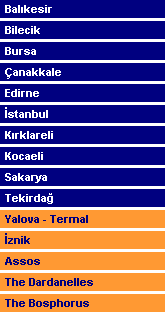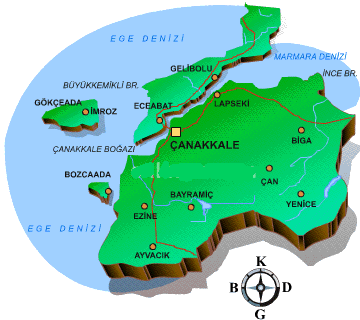| Çanakkale... |
|
The first waterway on the way of Istanbul, the place where a century was collapsed, the place where 500,000 soldiers have
lost their lives at Gallipoli, homeland of many civilizations including the ancient city known as Troy, the city of Heroes.
Canakkale, one of the Turkish cities, is located on the Hellespoint on the north-west part of Türkiye. The city has always
been strategically important because it has been a crossing point for armies, traders, migrating people since before history.
The province of Canakkale lies on both sides of the Dardanelles which connects the Sea of Marmara to the Aegean Sea. Its
shores touch both Europe (with the Gelibolu Peninsula) and Asia (with the Biga Peninsula) and there are ferries here
between the two sides. The well-equipped Canakkale Marina, besides those of Karabiga, Gelibolu, Bozcaada and Kucukkuyu,
hosts the colorful yachts which pass through the strait and make a stopover at Canakkale, to see this historical and
mythological-rich area-homeland of many widely known legends. The province has witnessed two very important battles in
history. One of them is the mythological war of Troy, which Homer immortalized in his Illiad. Archeological digs in Troy
(Truva) have proved that there had been nine separate periods of settlement. (3000 BC-AD 400). Here, one can see the
ruins of city walls in addition to the Wooden Horse of Troy. The other one is the Battle of Canakkale which took place
during World War I when Turkish troops under the command of Mustafa Kemal Ataturk maintained the defense of the region
against enemy forces and Canakkale has taken its place in history as "Canakkale; unpassable". To honor the
500,000 soldiers who gave their lives at Gelibolu (Gallipoli), this peninsula has been made a national park of remembrance.
There are memorial monuments here in surroundings of natural beauty. The small village of Assos (Behramkale) is a lovely
place, facing the Gulf of Edremit. It is founded on the site of Assos where there is the famous Temple of Athena built in
the 6th century BC. The panoramic view of the Gulf from the top of the acropolis is breathtaking and the remains
of Assos, surrounding the acropolis are worth visiting. Gokceada, the largest of the Turkish islands, and Bozcaada are also
in this region and they have many camping facilities. The Dardanelles Strait is one of the most important geological
feature of Canakkale. This is the almost 60 km (38 miles) long ribbon of water separating the continent of Europe from
the Asia Minor.
|
|

|


 286...
286...
 17...
17...
 464,975...
464,975...
 9,838...
9,838...
 26 E 24 - 40 N 09...
26 E 24 - 40 N 09...




 Click here for more info about "Çanakkale"...
Click here for more info about "Çanakkale"...



